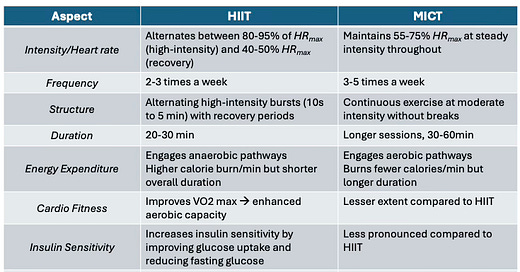The Science of HIIT: Unlocking Fitness, Longevity, and Metabolic Health
From new mitochondria to VO₂ max, how short bursts of effort deliver long-lasting health benefits—backed by science and beloved by experts
High-Intensity Interval Training (HIIT) is widely championed by top medical and fitness experts—Peter Attia among them—for its powerful impact on cardiovascular health and efficiency. HIIT is especially effective at improving VO₂ max1, a key marker of fitness and longevity, by pushing the body into near-maximal effort zones that activate both the aerobic and anaerobic systems Its ability to boost fitness, burn fat, and improve heart health in short intense bursts also makes it ideal for those with limited time. In this post, I would like to explore the science behind how exactly HIIT delivers these compelling benefits.
HIIT versus MICT
HIIT and Moderate-Intensity Continuous Training (MICT) differ significantly in terms of exercise intensity, duration, heart rate targets2, and overall structure, as shown in the table. HIIT is ideal for time-efficient workouts with rapid results, while MICT is suited for individuals preferring steady-state exercise over longer durations. HIIT is superior for cardio fitness, insulin sensitivity and more effective for reducing abdominal and visceral fat. On the other hand, MICT is better for sustained fat oxidation, reducing inflammation, and improving overall body weight. It may also be safer for individuals with chronic conditions like diabetes or coronary artery disease due to its lower risk of injury and inflammatory response.
HIIT’s Beneficial Cell Biology
HIIT is highly beneficial for metabolic health due to its profound effects at the cellular and molecular levels. Firstly, HIIT stimulates the production of PGC-1α (Proliferator-activated receptor Gamma Coactivator-1 alpha), a master regulator of mitochondrial biogenesis. PGC-1α activation leads to increased mitochondrial density and function in skeletal muscle cells, enhancing energy metabolism and oxidative capacity. Mitochondrial biogenesis—the process of creating new mitochondria—is essential for wellness because it enhances cellular energy production, supports metabolic health, and mitigates the effects of aging and chronic diseases. Evidence shows that mitochondrial dysfunction is linked to chronic conditions like diabetes, neurodegenerative diseases, and cardiovascular issues, while promoting biogenesis improves energy levels, cognitive function, and resilience against stressors. Dr. Casey Means, in Good Energy, emphasizes that mitochondrial health is foundational to overall well-being, as mitochondria power cellular processes that sustain physical and mental health. She argues that environmental changes—like sedentary lifestyles, processed diets, and chronic stress—have impaired mitochondrial function, leading to widespread metabolic dysfunction. In addition to HIIT, nutrient-rich diets and intermittent fasting also stimulate mitochondrial biogenesis while energy metabolism.
Studies also show that HIIT increases the expression of genes involved in glycolysis, glycogenesis3, and lactate transport (e.g., Hif-1α-regulated genes), boosting the muscle’s ability to utilize glucose efficiently during exercise. Long-term, HIIT improves both aerobic and anaerobic energy pathways, enabling better metabolic flexibility—the ability to switch between carbohydrate and fat utilization based on energy demands. More importantly, HIIT improves insulin sensitivity by enhancing glucose uptake in muscle cells, even in insulin-resistant states. This reduces fasting blood glucose and improves insulin sensitivity. In fact, studies have shown significant reductions in markers of insulin resistance (e.g., HOMA-IR) after HIIT interventions.
HIIT Benefits Cardiac Health
HIIT upregulates antioxidant enzymes, reducing oxidative stress in cells. This contributes to better endothelial function and reduced inflammation, which are critical for cardiac health. Cellular stress from HIIT induces adaptations such as increased capillary density, and oxygen transport capacity through enhanced red blood cell volume. These changes improve VO₂ max, a key indicator of cardiovascular fitness.
In summary, high-intensity cardio exercises like HIIT induce profound cellular adaptations that improve energy metabolism, enhance cardiovascular function, reduce insulin resistance, and promote lipid oxidation—making them highly effective for improving metabolic health.
Takeaway: High-Intensity Interval Training (HIIT) has gained widespread support from experts for its powerful effects on cardiovascular health, fat loss, and metabolic function. Compared to Moderate-Intensity Continuous Training (MICT), HIIT is superior for reducing visceral fat, enhancing insulin sensitivity, and promoting mitochondrial biogenesis. Cellular adaptations from HIIT include increased energy metabolism, oxidative capacity, and glucose utilization, which combat aging and chronic diseases like diabetes. These adaptations make HIIT a potent tool for improving fitness, longevity, and overall wellness.
Invite your friends If you enjoy Ram Krishnan’s posts, please share it with your friends The maximum amount of oxygen your body can utilize during intense physical activity. It's a measure of your cardiovascular fitness and aerobic endurance, reflecting how well your body can deliver oxygen to your working muscles.A higher VO2 max generally indicates better overall fitness and endurance.
To estimate your maximum heart rate, the most common and simple method is to subtract your age from 220.
The process by which the body converts excess glucose into glycogen, a storage form of glucose, primarily in the liver and muscle cells. This process is activated when blood glucose levels are high, allowing the body to store energy for later use




